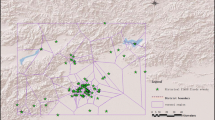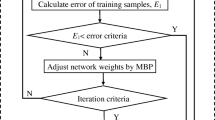Abstract
The derivation of an alert model for landslide risk management is a paramount problem for those sites which are affected by complex landslides involving strategic infrastructures as well as towns. This is a quite common scenario all over the world and then it is a primary problem for the management of geomorphological risk. Along the Adriatic Coast of south Italy, Petacciato landslide is peculiar, since it showed 11 reactivations between 1924 and 2009. It is a deep-seated landslide, and the history of its reactivations shows that even if generally related to quite abundant rainfall periods, there is no clear correlation between rainfall events and reactivations. For this reason, here, an analysis based on a data-driven evolutionary modeling technique is attempted, in order to identify an alert model based on cumulative rainfall heights. Modeling results are quite interesting and encouraging, since they are able to provide landslide forecasting whereas no false positive are ever returned. This work shows the results of this attempt as well as an analysis of the input to the modeling approach, in order to identify which are those cumulative rainfall heights which are physically sound with respect to the particular landslide.









Similar content being viewed by others
References
Angeli M.G. (1985) The role of anisotropic permeability on slopes instability conditions. In Proc. XI Int. Conf. of Int. Soc. Soil Mech. Found. Eng. S. Francisco, 4:2059–2063
Bäck T, Hammel U, Schwefel HP (1997) Evolutionary computation: comments on the history and current state. IEEE Trans Evol Comput 1(1):3–17. doi:10.1109/4235.585888
Bai SB, Wang J, Lu GN, Zhou PG, Hou SS, Xu SN (2009) GIS-based and data-driven bivariate landslide-susceptibility mapping in the Three Gorges Area, China. Pedosphere 19(1):14–20. doi:10.1016/S1002-0160(08)60079-X
Benjamin JR, Cornell CA (1960) Probability, statistics and decisions for civil engineering. McGraw-Hill, New York
Cancelli A, Pellegrini M, Tonnetti G (1984) Geological features of landslides along the Adriatic coast (Central Italy). In Proc. Int. Symp. on Landslides, Toronto, 2:7–17
Casnedi R, Crescenti U, D'Amato C, Mostardini F, Rossi U (1981) Il Plio-Pleistocene del sottosuolo molisano (Plio-Pleistocene and Molise underground). Geol. Rom. XX:1–42
Chang TC, Chien YH (2007) The application of genetic algorithm in debris flow prediction. Environ Geol 53:339–347. doi:10.1007/s00254-007-0649-2, 2007
Coello Coello CA (1999) A comprehensive survey of evolutionary-based multiobjective optimization techniques. Knowl Inform Syst 1(3):269–308
Cotecchia V (2006) The Second Hans Cloos Lecture. Experience drawn from the great Ancona landslide of 1982. Bull Eng Geol Environ 45:1–41. doi:10.1007/s10064-005-0024-z
Fiorillo F (2003) Geological features and landslide mechanisms of an unstable coastal slope (Petacciato, Italy). Eng Geol 67(3–4):255–267. doi:10.1016/S0013-7952(02)00184-9
Fiorillo F, Guadagno FM (2000) Analysis of rainfall patterns triggering reactivations of a large landslide in Pleistocene clay in Molise (Italy). In Proc. of the 8th Int. Symp. on Landslides, Thomas Telford, 2, 553–557
First Italian Workshop on Landslides (2009) Rainfall-induced landslides: mechanisms, monitoring techniques and nowcasting models for early warning systems. Naples, 8–10 June 2009
Flentje P, Stirling D, Chowdhury R (2007) Landslide susceptibility and hazard derived from a landslide inventory using data mining—an Australian case study. In: Proceedings of the First North American Landslide Conference, Landslides and Society: Integrated Science, Engineering, Management and Mitigation, Vail, Colorado 3–8 June 2007
Giustolisi O, Savic DA (2006) A symbolic data-driven technique based on evolutionary polynomial regression. J Hydroinform 3(8):207–222. doi:10.2166/hydro.2006.020
Giustolisi O, Savic DA (2009) Advances in data-driven analyses and modelling using EPR-MOGA. J Hydroinform 11(3–4):225–236. doi:10.2166/hydro.2009.017
Giustolisi O, Doglioni A, Laucelli D, Savic DA (2004) A proposal for an effective multiobjective non-dominated genetic algorithm: the OPTimised Multi-Objective Genetic Algorithm, OPTIMOGA, Report 2004/07, School of Engineering Computer Science and Mathematics, Centre for Water Systems, University of Exeter
Giustolisi O, Doglioni A, Savic DA, di Pierro F (2008) An evolutionary multi-objective strategy for the effective management of groundwater resources. Water Resour Res 44:W01403. doi:10.1029/2006WR005359
Glade T, Crozier M, Smith P (2000) Applying probability determination to refine landslide-triggering rainfall thresholds using an empirical “Antecedent Daily Rainfall Model”. Pure Appl Geophys 157(6–8):1059–1079. doi:10.1007/s000240050017
Goldberg DE (1989) Genetic algorithms in search, optimization and machine learning. Addison-Wesley, Reading
Guerricchio A, Melidoro G (1996) Rischi da grandi frane nella fascia costiera adriatica (Large Landslide Hazard along the Adriatic coastline). In Proc. of Prevention of Hydrogeological Hazard: the role of scientific research, Italian National Research Council (CNR,) 5–7 November 1996, Alba (Italy), 1:317–330
Guerricchio A, Melidoro G, Simeone V (1996) Le grandi frane di Petacciato sul versante costiero adriatico (The large landslides of Petacciato on the Adriatic coastline). Mem Soc Geol Ital 51(2):607–632
Hodge RA, Freeze RA (1977) Groundwater flow system and slope stability. Can Geotech J 14(4):466–477. doi:10.1139/t77-049
Iverson RM (2000) Landslide triggering by rain infiltration. Water Resour Res 36(7):1897–1910. doi:10.1029/2000WR900090
Kawabata D, Bandibas J (2009) Landslide susceptibility mapping using geological data, a DEM from ASTER images and an Artificial Neural Network (ANN). Geomorphology 113(1–2):97–109. doi:10.1016/j.geomorph.2009.06.006
Ljung L (1987) System identification: theory for the user. Prentice-Hall, Upper Saddle River, p 672
Lu P, Rosenbaum MS (2003) Artificial neural networks and grey systems for the prediction of slope stability. Nat Hazards 30(3):383–398. doi:10.1023/B:NHAZ.0000007168.00673.27
Melchiorre C, Matteucci M, Azzoni A, Zanchi A (2008) Artificial neural networks and cluster analysis in landslide susceptibility zonation. Geomorphology 94(3–4):379–400. doi:10.1016/j.geomorph.2006.10.035
Patacca E, Scandone P (2007) Geology of the Southern Apennines. In: Mazzotti A, Patacca E, Scandone P (eds) Results of the CROP Project, Sub-project CROP-04 So, Spec. Issue 7(2007), 75–119
Sengupta A, Gupta S, Anbarasu K (2010) Rainfall thresholds for the initiation of landslide at Lanta Khola in north Sikkim, India. Nat Hazards 52(1):31–42. doi:10.1007/s11069-009-9352-9
Tatard L, Grasso JR, Helmstetter A, Garambois S (2010) Characterization and comparison of landslide triggering in different tectonic and climatic settings. J Geophys Res 115:F04040. doi:10.1029/2009JF001624
Van Asch ThWJ, Buma J, Van Beek LPH (1999) A view on some hydrological triggering systems in landslides. Geomorphology 30(1–2):25–32. doi:10.1016/S0169-555X(99)00042-2
Van Veldhuizen DA, Lamont GB (2000) Multiobjective evolutionary algorithms analyzing the state-of-the-art. Evol Comput 8(2):125–144. doi:10.1162/106365600568158
Acknowledgments
Rainfall data have been provided by (ex) Servizio Idrografico e Mareografico Nazionale of Pescara (1924–1998 period) and Centro Funzionale del Servizio per la Protezione Civile of Regione Molise (1999–2009 period).
Author information
Authors and Affiliations
Corresponding author
Rights and permissions
About this article
Cite this article
Doglioni, A., Fiorillo, F., Guadagno, F.M. et al. Evolutionary polynomial regression to alert rainfall-triggered landslide reactivation. Landslides 9, 53–62 (2012). https://doi.org/10.1007/s10346-011-0274-8
Received:
Accepted:
Published:
Issue Date:
DOI: https://doi.org/10.1007/s10346-011-0274-8




